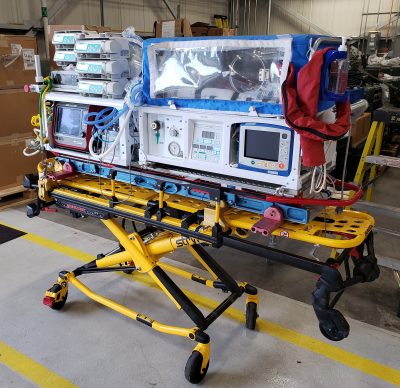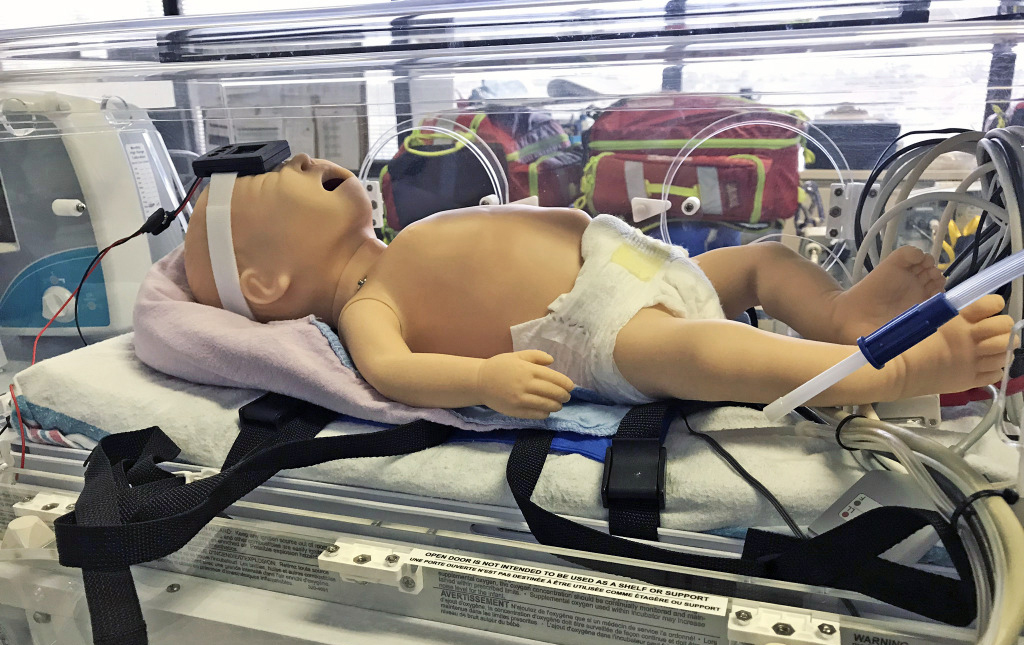Keeping Babies Safe in Medical Transit
Joseph Mathieu
In 2022, over 90 per cent of babies born in Canada were delivered at term—between 37 and 41 weeks—with the majority being healthy enough to require little to no supplemental medical intervention.
However, every year, thousands of newborns require specialized medical care, with those who are born prematurely often needing immediate, intensive care. In 2022, there were almost 29,000 pre-term babies born within Canada, some arriving in the 25th week of pregnancy or even earlier.
Within Ontario, newborn critical care isn’t always close at hand for the families who rely upon it. Patients sometimes need to move to specialty neonatal centres via one of four specialized pediatric transport teams based at McMaster Children’s Hospital in Hamilton, The Hospital for Sick Children (SickKids) in Toronto, or the Children’s Hospital of Eastern Ontario (CHEO) in Ottawa.

Despite the most advanced technologies and the best preventative measures, there are still risks to these most vulnerable patients when they’re transferred. Luckily, the need to protect babies is one everyone can get behind.
This idea is at the core of Mechanical and Aerospace Engineering Prof. Rob Langlois’ large collaboration that spans Carleton, the University of Ottawa, SickKids, CHEO and two divisions of the National Research Council (NRC). Their project is funded by a Canadian Institutes of Health Research (CIHR) grant to better understand how the exposure to vibration and sound can be reduced for newborn patients in transit.
This research is conducted in both rigorous lab experiments and in the field, during simulated transportation of critical newborns. As the head of Carleton’s Applied Dynamics Laboratory, Langlois leads research on vehicles in motion—from cars, buses and fire trucks to ships, helicopters and ambulances.
“We’ve also got lots of experience with the dynamics of things that are secured in moving environments,” says Langlois. “Whether it’s a helicopter secured to the deck of a rolling ship, or a stretcher secured in an ambulance, they share a lot of the same issues.”

Between Langlois’ lab, the NRC’s Automotive and Surface Transportation Research Centre and the NRC’s Flight Research Lab, his team has conducted a wide variety of experiments that involve shaking, rotating and vibrating medical equipment made for transporting infants. They have even shaken an entire ambulance complete with a stretcher, medical equipment, and patient mannequin inside by moving the individual wheels up and down to recreate a typical bumpy road.
The CIHR project studies the effects of rough and smooth transport in a ground ambulance, airplane, helicopter and within hospitals themselves, considering the placement and anchoring of the stretcher, the vehicle’s operating conditions, and corresponding motion. Through a better understanding of how outside vibrations affect the patient, the team looks to find technological improvements and develop novel approaches for real-time monitoring.
“This work will improve infant safety during medical transportation and find ways to mitigate noise and vibration exposure to the patients,” says Langlois.
A New System is Born
In 2012, the Provincial Council for Maternal Child Health recommended that neonatal transportation teams at Ontario NICUs should meet the same standards and use the same equipment. Its Maternal‐Child Transport Advisory Committee (MCTAC)—made up of health professionals and transport practitioners tasked with providing advice and recommendations to improve safety, quality of care, and patient and family experiences—helped design the Neonate Patient Transport System (NPTS). The first fully standardized system of its kind in Canada, it took three years to design and build and another three to be certified for use in the field.
The NPTS features a ventilator, medical air, infusion pumps, monitors for vital signs, a defibrillator and several other devices. Its isolette—the clear glass observation box on top of the equipment—is heated and the baby is secured within with a five-point harness. Among its many innovations are its compact size (approx. 400 pounds) and its ability to latch securely onto medical stretchers to move infant patients to an NICU safely and efficiently.
Once the NPTS began its rollout in 2015, transport clinicians noticed that patients seemed to be experiencing more vibration as they were moved. Although specialized neonatal transport has been shown to reduce mortality in pre-term babies, the risk of transport in this vulnerable population is high. Exposure to noise and vibration in the back of an ambulance or in an airborne helicopter needs to be as limited as possible.

In 2017, Carleton Systems and Computer Engineering Prof. James Green was working with Masters student Roger Selzler in the CHEO NICU on a separate project. Dr. Stephanie Redpath, the Medical Director of CHEO’s Transport Team, invited them to investigate the new transport system’s vibration levels as it wheeled from The Ottawa Hospital General Campus‘ halls into CHEO’s.
Green and Selzler did find vibrations to be elevated, and they expanded their scope to measure the vibrations in a ground ambulance while also looking into different mattresses and harnesses.
Institutions & Industry Partner Up
Over a short period of time, Green and Redpath’s team grew to include Langlois, Carleton Systems and Computer Engineering Prof. Adrian Chan, neonatologist Dr. Hilary Whyte from Toronto’s SickKids, and other researchers. Their testing became even more rigorous in 2020 with a $500,000 Collaborative Health Research Projects grant.
Today, the CIHR-funded project includes support from the Ottawa Paramedics Service (OPS), medical transport agency Ornge, medical stretcher manufacturer Stryker Medical and International Biomedical, which designed and manufactured the NPTS.
The project also includes the contributions of many undergraduate and graduate students. Mechanical and Aerospace Engineering PhD student Keely Gibb joined the project in 2020 and she is developing a model of a medical stretcher to replicate its real-life dynamics.
The project has attracted academics and researchers from a multitude of different fields, and because of all the equipment, vehicles and facilities required for the testing, the input from industry partners has been essential. According to Langlois, everyone has been eager to help.
“There’s just a lot of good will,” says Langlois.
When flight tests with Ornge were delayed, the RCMP agreed to do some flight testing with their PC-12 airplane. The team was able to lease a critical piece of medical transport equipment from Guardian Air Transport in Northern Arizona for a generous three months. And when they ran into challenges with the NPTS being too large to fit on the NRC’s electrodynamic shaker, NRC staff worked with the Carleton researchers to build an expanded support structure so they could complete their tests.
For Gibb, it’s been rewarding to work on such an important real-world problem and see so much collaboration between institutions and industry. At the end of the day, keeping thousands of babies safe and sound is a powerful idea that brings people together.
“That motivation is one that resonates with many,” says Gibb. “Improving safety for these vulnerable patients is just a universal desire.”